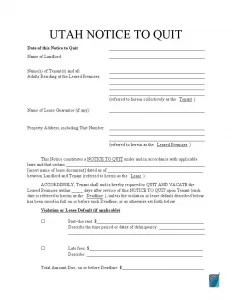Utah Eviction Notice Forms
A legal eviction process is called an unlawful detainer suit in the state of Utah. Providing a lawful reason and a court order, the landlord can legally make the tenant vacate his property. Any attempts of the landlord to evict the resident without an authorized order are considered illegal.
One should learn all the state legal peculiarities before going to court and filing for a lawsuit. Hereunder, we provide you all the necessary information and Utah Eviction Notice templates.

Build Your Document
Answer a few simple questions to make your document in minutes
Save and Print
Save progress and finish on any device, download and print anytime
Sign and Use
Your valid, lawyer-approved document is ready
Utah Eviction Laws
All the procedures concerning landlord-tenant relations are regulated by the Utah Code. The eviction procedures are described in Part 8 of the Code (Forcible Entry and Detainer).
Landlords have to provide a lawful reason to launch an eviction process. Usually, the conflict arises when the tenant fails to comply with his material obligations, for example, to make timely payments. The owner can issue a nuisance notice if they suspect criminal activity, gambling, or rowdy behavior taking place on the premises. However, they should prove their suspicions before filing a complaint.
The state of Utah supports the federal Fair Housing Act, which, in turn, prohibits any discrimination based on religion, skin color, nationality, sex, social status, or income. Any of these cannot lead to eviction.
Upon the three-day period expiration, the tenant ought to vacate or prove that he or she was acting by the agreement. But there are other legal means to defend oneself. The tenant can respond with a counter lawsuit if the dwelling unit does not meet the Utah Fit Premises Act requirements. Under these norms and regulations, tenants can do necessary repairs and demand remedies from the property owner if the costs do not exceed two months’ rent amount.
Utah Eviction Notice Laws Details
| Rent Grace Period | Not specified |
| Notice of Non-Payment | 3 days |
| Notice of Non-Compliance | 3 days |
| State Laws | Utah Code, Sections 78B-6-801 to 78B-6-816 |
Eviction Notice Types Used in Utah
You can use legal assistance to compose an Eviction Notice. Or, you can also use our software tools to build a form template yourself. There are four types of free eviction notice currently used in Utah:
- 3-day failure to pay letter
- 3-day violation of the agreement letter
- 3-day Notice Illegal Activity Notice
- 15-day month-to-month termination
The landlord can issue a 3-day Non-Payment Notice in cases when the tenant does pay the rent in due time. The tenant gets a three-day window to pay the arrears. If he or she does not obey, the landlord is free to take further action.
One can use a 3-day Non-Compliance Notice if the resident does not comply with the lease conditions. All rights and obligations are stated in the contract. If the tenant breaches any of them, the landlord can issue a violation notice.
If the property owner suspects that an unlawful action takes place on the premises, he or she can issue a 3-day Illegal Activity Notice. It is also called a Nuisance Eviction Notice. A nuisance involves any activity that poses a direct threat to the health, security, or peaceful enjoyment of others.
Either side can use a 15-day Termination Notice to end a monthly tenancy. This one is a so-called No Cause Notice. If one of the sides launches a lease termination at will, the parties agree on the closing conditions. Once all the obligations are fulfilled, the resident can move out and avoid the penalties and further liability.

Eviction Process in Utah
- Generate a Letter to Resign
A notice launches any legal eviction process. Thus, the landlord warns the tenant about an existing contract breach and asks to take action or leave. The parties may come to an agreement during the period indicated in the notice. But if the main problem did not go away, the landlord can go on with the eviction procedure.
- File the letter in Court
Following the notice, the resident needs to fix things or quit. If the lessee fails to do either, the proprietor will have every right to address the local District Court with this problem. The property owner fills out the necessary documents and serves them to the resident. Utah court system obtains an electronic workflow system that one can use to create and send the documents.
- Deliver the Paperwork to the Lessee
The lessor shall not deliver the documents in person but does have to make sure the delivery was successful. One can ask a local sheriff or another specialist to serve the court forms to the defender. All the delivery records, including the return receipt, must be provided to the court as evidence.
- Meet the Defense
At the next stage of the process, the tenant will have an opportunity to respond to the allegations. He or she needs to fill out an Answer Form and forward it to the court.
- Wait for the Judgement
At the final stage, the court gets to review the case. During the hearing, both parties try to prove their right. If the judge rules in favor of the claimant, the court then issues an Order of Restitution. With this document, the local sheriff can make the tenant obey and leave the subject property.
Utah Eviction Court Forms
As we have mentioned above, the owner needs to provide an authorized court order for eviction. The landlord has to contact the District Court closest to the premises to get a list of documents required for a lawsuit. Let us take a closer look at the paperwork one needs to go through.
First up, the landlord sends out a notice declaring an intention to take further action.
Then, he or she fills out a Complaint Court Form.
In plain words, it is a petition, by which the owner outlines the case essence and asks for mediation. The landlord also provides a printed copy of the mentioned notice to the court along with the other papers.
Another important court form is the Summons.
It determines the period during which the defender has to make a counter-announcement. If the latter fails to respond, he or she has to come to the hearing at the designated time.
Answer Form
After the Summons is served, the defender gets and fills out an Answer Form to fend off the allegations. The response shall contain a clear statement, whether the defendant agrees with those allegations.
An Order of Restitution effectively ends the eviction process. If the judge decides in the landlord’s favor, the court issues the Order of Restitution. The document effectively ends the lease and imposes a legal obligation upon the tenant to quit within a certain period.

Try out our document maker to personalize any form offered on FormsPal to your preferences. Here is a list of other printable Utah documents we offer.
